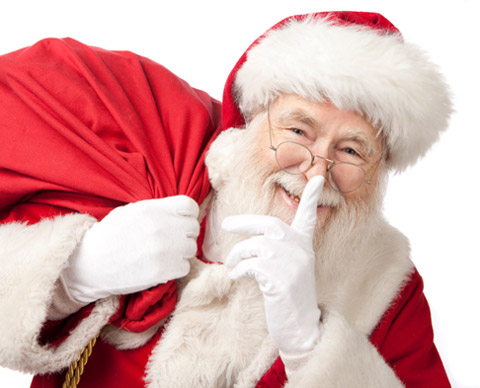當(dāng)前位置: Language Tips> 合作專區(qū)> 英語學(xué)習(xí)專欄
分享到
圣誕老人源于歐洲的民間傳說,一般認(rèn)為圣誕老人來自北極,如芬蘭的拉普蘭地區(qū)有一個圣誕老人村。每年圣誕節(jié),總會有小孩兒寄信給圣誕老人,告知其希望收到的圣誕禮物,而郵局更會有專人回復(fù)這些信件。睡夢中圣誕老人送驚喜是孩子們一年一度的殷切期盼,而父母們則借機(jī)鼓勵他們聽話、好好表現(xiàn)。但隨著年齡的增長,孩子的心里逐漸有了疑問:真的有圣誕老人嗎?請看作者如何解開孩子們這一心中疑團(tuán)。

By Betty Liu
郭小華 注
Christmas is perhaps the most important holiday in American culture. It is certainty a favorite, especially among children everywhere. On Christmas Eve, children sit out with parents in the living room hanging stockings, setting up a Christmas tree, eating candy canes, and setting up milk and cookies for Santa Claus. Perhaps the most beloved figure in American history, Santa Claus has become an important icon for Christmas.
They say that Santa Claus usually lives in the North Pole in his workshop with his wife, Mrs. Claus and his worker elves (who make the toys). Children from all over the world write to him to tell him what they want for Christmas. On Christmas Eve, he travels the world on his sleigh, which is pulled by his magic reindeer, and visits all the good little boys and girls of the world. He comes down the chimney and fills their stockings with treats and leaves them presents under the tree. However, naughty boys and girls don’t receive gifts and they will get lumps of coal in their stockings.
I remember believing in Santa when I was a very young girl. However, as I grew older, I learned many facts that “proved” his existence as false. Always inquisitive by nature and very keen on the scientific method of experimentation, I was determined to use tests and observations to determine whether Santa Claus was real.
The first year of tests happened when I was 5. I decided that if I stayed up all night on Christmas Eve, I could see if Santa really did come down the chimney. However, that was a futile attempt. I fell asleep that year, and when I woke up I saw that the milk and cookies I left for Santa were all gone and I had a beautifully wrapped present under the tree.
The next year, I was able to test if location was an issue with Santa’s deliveries. That year, my family spent Christmas with the family of one of my mother’s friends. At the time, I decided that if Santa was all-knowing (as the song says “He knows where you are sleeping, he knows when you’re awake. He knows if you’ve been bad or good, so be good for goodness’ sake!) he would know I wasn’t home. Sure enough, there was a pretty pink package waiting for me the next morning, and inside was a pretty pink bathrobe.
At age 7, I came up with my ultimate test to see if Santa was real. That year, I didn’t send out my Christmas letter to Santa. At first it was because I didn’t want anything for Christmas, but this turned into a plot. By this point, I already decided that Santa wasn’t real, but I wanted empirical evidence to support this (it’s much harder to try to prove something doesn’t exist, rather than trying to prove that it does). That year was interesting, because on Christmas Eve, my mother dragged me to our local Wal-Mart and led me around the toy section. I refused to say a word, but did let my eye linger on a ballet set. I figured that “Santa” wouldn’t know what to get me because he shouldn’t be able to read my mind. However, mother would know everything that caught my eye in the store. If I got the ballet set the next morning, I would have my evidence. Christmas morning, there was the ballet set, sitting under the tree. As I didn’t use it much, mother ended up returning it a few days later. She claimed Santa was generous enough to leave a receipt. That was the end to my mission to discover the existence of Santa.
Now, I can look back on all of these antics with fond nostalgia. The magic and mystery of it all made Christmas a fun time. Santa was a big part of my childhood, and in the future, I want it to be a part of my child’s as well.
Vocabulary
1. Santa Claus: 圣誕老人,源于歐洲的民間傳說,最經(jīng)典的形象是頭戴紅色圣誕帽子,留著白色大胡子,身穿紅色棉衣,腳登紅色靴子。傳說每到12月24日晚上,他都會駕乘12頭馴鹿拉著的雪橇,從煙囪進(jìn)入屋里,偷偷地把禮物放在好孩子床頭的襪子里,或者堆在壁爐旁的圣誕樹下。
2. Christmas: 圣誕節(jié),基督教節(jié)日,定在12月25日,紀(jì)念耶穌的誕生。
3. 圣誕前夜,孩子們與父母一起坐到深夜,在客廳懸掛長筒襪,擺放圣誕樹,吃棒棒糖,并為圣誕老人準(zhǔn)備牛奶和餅干。Christmas Eve: 圣誕前夜,平安夜;sit out: 坐到結(jié)束;stocking: 長筒襪;candy cane: 一種紅白相間、一端彎曲的棒棒糖,也叫拐杖糖,形狀像英文字母J,代表耶穌基督的圣名,常在圣誕節(jié)吃。
4. beloved: 鐘愛的,受愛戴的;icon: 圣像,圖標(biāo)。
5. North Pole: 北極;elf: 小精靈。
6. sleigh: 雪橇;reindeer: 馴鹿(體型較大,生有枝狀角,生活在北極地區(qū))。
7. chimney: 煙囪;treats: 好吃的,好玩的。
8. naughty: 淘氣的;lump: 塊,團(tuán)。
9. prove: 證明某事屬實(shí),原來是;false: 虛假的。
10. 由于我天生好打聽,且非常熱衷于科學(xué)實(shí)驗(yàn)方法,因此我下決心要通過試驗(yàn)和觀察來確定圣誕老人是否確有其人。inquisitive: 好奇的,好打聽別人的事情的;by nature: 生性,天生地;keen on: 熱衷于。
11. stay up: 熬夜,不睡覺;all night: 整夜,通宵。
12. futile: 無效的,無用的;attempt: 嘗試。
13. leave…for: 留下,留給某人;wrap: 包,裹。
14. location: 地點(diǎn),位置;delivery: 投遞,交付。
15. all-knowing: 無所不知;for goodness’ sake: 看在上帝(老天爺)份上,務(wù)請。
16. sure enough: 果然,確實(shí);bathrobe: 浴袍。
17. come up with: 提出,想出; ultimate: 最后的,終極的。
18. 此時,我已經(jīng)確信圣誕老人不是確有其人,但我想通過經(jīng)驗(yàn)證據(jù)來證明這一點(diǎn)(要證明某物并不存在比證明它確實(shí)存在可難多了)。empirical evidence: 經(jīng)驗(yàn)證據(jù);support: 支持,證明。
19. drag: 拉,扯;Wal-Mart: 沃爾瑪百貨有限公司,美國跨國零售企業(yè),總部設(shè)在阿肯色州本頓維爾,是世界上最大的連鎖零售商;section: 區(qū),部分。
20. linger on: 流連,繼續(xù)逗留;ballet: 芭蕾舞。
21. figure: 想,估計;read one’s mind: 看出某人的心思。
22. catch one’s eye: 吸引某人注意。
23. claim: 聲稱;generous: 慷慨;receipt: 收據(jù)。
24. look back on: 回顧,回想;antics: 滑稽動作,古怪姿態(tài);nostalgia: 懷舊,對往事的懷戀。
25. magic: 魔法;mystery: 神秘;fun time: 快樂時光。
(來源:英語學(xué)習(xí)雜志 編輯:丹妮)
上一篇 : 瓦格納的圣誕諾言
下一篇 : 美國傳統(tǒng)節(jié)日——校友返校周
分享到
關(guān)注和訂閱


關(guān)于我們 | 聯(lián)系方式 | 招聘信息
電話:8610-84883645
傳真:8610-84883500
Email: languagetips@chinadaily.com.cn